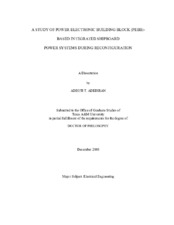| dc.description.abstract | The U.S. Navy has developed in their ships, and is continually improving, electric propulsion, ship service power, and electric loads. The latest topology under design is the integrated power system (IPS). The IPS entails the all electric ship concept with electric propulsion, direct current (DC) distribution, and modular technology. In the all electric ship concept, ship propulsion and ship service loads are powered by alternating current (AC) generation. For the IPS, power electronics conversion is to be utilized to convert alternating current (AC) generation to direct current (DC) distribution. As state-of-the-art power electronics, the Navy plans to use power electronic building blocks (PEBB) technology in its IPS. A U.S. naval shipboard power system is required to be a highly reconfigurable system to enhance its survivability and reliability. Reconfiguration is a change in the shipboard power system state for various reasons such as new topology, changing missions and emergencies. It was decided to study the behavior of a PEBB-based integrated shipboard power system during reconfiguration. Since no real time operation data was available, the problem was studied through the simulation of reconfiguration scenarios on a scaled-down computer model of an IPS in MATLAB. Reconfiguration scenarios were determined and staged, and an AC/DC power system stability assessment methodology was applied by decoupling the IPS test system around an intrazonal bus. The coupled system of the test IPS, consisted of two dynamic 4160 VAC generators, two rectifiers, two DC-DC converters between the rectifiers' output looped bus and the downstream intrazonal 775V busses, inverters, buck converters, AC loads and DC loads. There was modeling of excitation perturbations which introduced errors in the assessment of the stability requiring an approximation analysis. The study found that the DC bus of interest was stable for all nine reconfiguration scenarios staged, but it found that other busses were not stable for two of the scenarios. The study further found that lower stability margins occurred at lower frequencies of about 1Hz for stable scenarios. It concluded that there were tangible benefits to advancing the shipboard power system architecture to the IPS topology because of the good stability results. | en |


